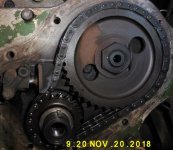doc50
Jedi Trainee
Offline
Greetings again.
My new to me '58 Met seems tight, no smoke, but even after adjusting valves (.015) there is a 'Singer Sewing Machine' clackety sound from the very front of the motor. I took the oil fill cap off and the valves are nice and quiet. It's all from the front, and the idle constantly searches. I don't think it's the carb, because the changes in RPM are about every 5 seconds, up and down, up and down.
Am I circling the right diagnosis, a loose chain/tensioner?
I'm not professional mechanic but I have rebuilt several engines and I can't think of anything else that would make that noise and I know valve timing changes would affect the idle.
New developement: The crank bolt is stuck. Does anyone have a real neat way to cajole it? I'm thinking of heating it till red hot, letting it cool a couple minutes and go for it. Please stop me if that's a very bad idea...
Thanks.
Thom
1958 Nash Met 'Chuckles'
1973 MG Midget 'Midge'
My new to me '58 Met seems tight, no smoke, but even after adjusting valves (.015) there is a 'Singer Sewing Machine' clackety sound from the very front of the motor. I took the oil fill cap off and the valves are nice and quiet. It's all from the front, and the idle constantly searches. I don't think it's the carb, because the changes in RPM are about every 5 seconds, up and down, up and down.
Am I circling the right diagnosis, a loose chain/tensioner?
I'm not professional mechanic but I have rebuilt several engines and I can't think of anything else that would make that noise and I know valve timing changes would affect the idle.
New developement: The crank bolt is stuck. Does anyone have a real neat way to cajole it? I'm thinking of heating it till red hot, letting it cool a couple minutes and go for it. Please stop me if that's a very bad idea...
Thanks.
Thom
1958 Nash Met 'Chuckles'
1973 MG Midget 'Midge'
Last edited:

 Hi Guest!
Hi Guest!

 smilie in place of the real @
smilie in place of the real @
 Pretty Please - add it to our Events forum(s) and add to the calendar! >>
Pretty Please - add it to our Events forum(s) and add to the calendar! >> 

